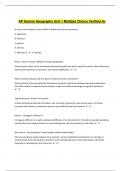AP Human Geography Unit 1 Multiple Choice Verified A+
A ratio of the number of items within a defined unit of area measures
A. dispersion
B. direction
C. pattern
D. density
E. diffusion ✔️✔️D. density
How is "sense of place" defined in human geography?
Sense of place refers to the emotional connection people have with a specific location, often influenced
by personal experiences, memories, and cultural significance. ✔️✔️
What is distance decay, and how does it influence human interaction?
Distance decay is the principle that as distance increases, interaction between two places decreases.
This often results in reduced communication, trade, and cultural exchange over greater distances.
✔️✔️
Explain the term "friction of distance."
Friction of distance describes the effort, cost, and time required to travel across space. As friction
increases with distance, interactions become more difficult and less frequent. ✔️✔️
What is "contagious diffusion"?
Contagious diffusion is a rapid, widespread diffusion of a cultural trait or innovation, typically spreading
outward from the original location to surrounding areas, like the spread of a viral video. ✔️✔️
How does a "core-periphery" model explain spatial relationships?
The core-periphery model explains how economic, social, and political connections are stronger in
central (core) areas and weaken toward the outer (peripheral) areas. This model helps understand
inequality in development and resources. ✔️✔️
,What is spatial association in geography?
Spatial association refers to the degree to which two or more phenomena are similarly distributed or
occur together in the same space. High spatial association indicates a strong connection or correlation
between them. ✔️✔️
What is a "polar projection," and what is it used for?
A polar projection maps the Earth from the perspective of the poles, often used for air travel and
navigation as it highlights the shortest routes over polar regions. ✔️✔️
Define acculturation in the context of cultural diffusion.
Acculturation is the process in which individuals or groups adopt certain traits or practices of another
culture, usually following prolonged contact, while still retaining elements of their original culture.
✔️✔️
What is assimilation, and how does it differ from acculturation?
Assimilation occurs when an individual or group fully adopts and integrates into a different culture,
often losing distinctive cultural traits, whereas acculturation allows for the coexistence of both cultures.
✔️✔️
What is spatial diffusion, and what are its main types?
Spatial diffusion is the spread of ideas, behaviors, or characteristics from one place to another. The main
types are relocation diffusion, contagious diffusion, hierarchical diffusion, and stimulus diffusion.
✔️✔️
What is an "equal area projection," and why is it important?
An equal area projection maintains accurate area proportions across the map, which is essential for
representing the relative size of countries or regions accurately, often used in demographic or resource
maps. ✔️✔️
How does geographic information differ between a "census" and a "survey"?
, A census is a comprehensive count of an entire population, often including extensive demographic
details, while a survey collects specific data from a sample of the population, providing insights on
trends or preferences. ✔️✔️
What does spatial distribution help geographers understand?
Spatial distribution helps geographers understand how people, resources, or activities are arranged
across Earth’s surface, allowing for analysis of patterns, clustering, and dispersion in data. ✔️✔️
What is a "reference map," and how does it differ from a "thematic map"?
A reference map provides general geographic information, like locations and physical features, while a
thematic map emphasizes a specific theme, like climate or population density, to reveal spatial patterns.
✔️✔️
Explain "cultural ecology" in human geography.
Cultural ecology studies the relationship between human societies and their natural environments,
focusing on how cultural practices influence and adapt to environmental conditions. ✔️✔️
What is placelessness, and what causes it?
Placelessness refers to the loss of unique characteristics in a location, often due to globalization or
homogenization, resulting in places that lack distinctive identity (e.g., chain stores replacing local
businesses). ✔️✔️
What is "stimulus diffusion"?
Stimulus diffusion occurs when an idea or innovation is not fully adopted but inspires local adaptations
or similar practices, like fast food menus adapting to local tastes in different countries. ✔️✔️
How does a "flow map" represent spatial interaction?
A flow map uses arrows or lines to show the movement of goods, people, or ideas between places,
often with thicker lines representing higher volumes of interaction. ✔️✔️
What are "dot density maps," and how are they useful?




